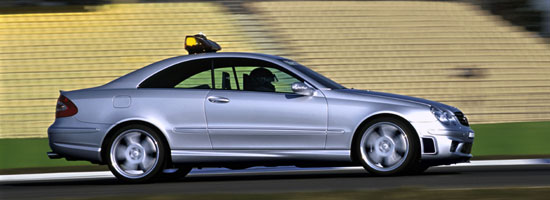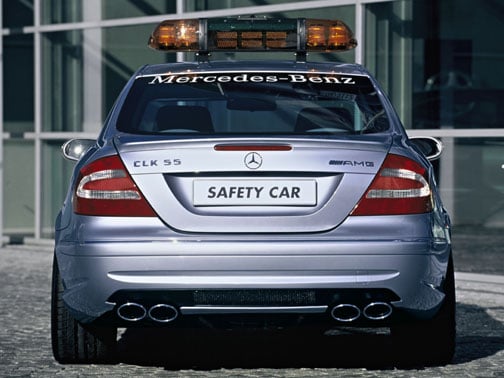
Displaying dynamism and exclusivity in equally high measures, the road version of the Mercedes-Benz CLK 55 AMG has found many enthusiastic owners all around the globe. Now the high-performance Coupé has made its sporting debut as the official Formula One Safety Car.
Piloted by experienced Mercedes-Benz DTM driver Bernd Mayländer, the Safety Car intervenes in the event of accidents, adverse weather conditions or other critical situations which jeopardise safety on the race track. As the official Safety Car of the FIA (Fédération Internationale de l’Automobile), the CLK 55 AMG will be on call at each of the 16 Formula One circuits, enabling it to display its sporting prowess in front of a world-wide audience of potentially billions.
Permanent technology transfer from the world of motor racing -
The Safety Car has to fulfil stringent requirements; after all, its job is to lead some of the world's fastest racing cars and drivers around the circuit at high speed, sometimes for several laps at a time. If the speed were too low, the engines in the Formula One machines would overheat and the brakes and tyres would cool down too rapidly. In preparation for its new role among the motor-racing elite, the Coupé from Affalterbach in Germany has been fine-tuned to ensure maximum performance and an extremely long service life. Engineers and technicians at Mercedes-AMG GmbH were able to call upon 35 years of motorsport experience and a highly impressive track record in the development of dynamic, high-performance cars.
Precision modified for optimum driving dynamics and service life -
Powerful acceleration is provided by the AMG eight-cylinder engine with 5.5-litre displacement and an output of 270 kW/367 hp. Modifications introduced to optimise aerodynamics, the cooling system, fuel tank, fuel supply, suspension and brakes ensure not only superb driving dynamics but also an extremely long service life and highly impressive reliability – whether it be in the tropical heat of the Malaysian Grand Prix or in cooler climes such as the Nürburgring in Germany.
Extensive range of on-board signalling and communications equipment -
 At first glance, the main differences between the Safety Car and its standard production counterpart are the F1 logos and the emergency lights on the roof. When the Safety Car is called into action, Bernd Mayländer first switches on the green light, signalling that he is about to join the middle of the field. This is also the signal for any F1 cars behind him to overtake. Once the Safety takes the lead position in the field, the orange flashing lights are switched on. These tell the F1 drivers that no overtaking whatsoever is allowed. The white stroboscopic lights in the headlamps and taillights perform a general signalling function in that they always flash when the Safety Car is in action.
At first glance, the main differences between the Safety Car and its standard production counterpart are the F1 logos and the emergency lights on the roof. When the Safety Car is called into action, Bernd Mayländer first switches on the green light, signalling that he is about to join the middle of the field. This is also the signal for any F1 cars behind him to overtake. Once the Safety takes the lead position in the field, the orange flashing lights are switched on. These tell the F1 drivers that no overtaking whatsoever is allowed. The white stroboscopic lights in the headlamps and taillights perform a general signalling function in that they always flash when the Safety Car is in action.
To enable communication with Race Control, the Safety Car is fitted with a vast array of equipment, including radio systems as well as several TV cameras mounted inside and outside the vehicle. This extra equipment requires its own power supply with a second alternator and battery. Two racing-design bucket seats with 4-point belts, black/grey leather appointments and a titanium-coloured carbon trim emphasise the uniquely special character of the new FIA Safety Car made by AMG.
Four generations of Safety Cars since 1997 -
Following in the tracks of the first CLK 55 AMG (since 1997), the CL 55 AMG (since 2000) and the SL 55 AMG (since 2001), the new CLK 55 AMG is a fourth Safety Car generation from Mercedes-Benz. This, in addition to the company’s Formula One racing team, is additional proof of the company’s long-term commitment to the Formula One World Championship.
Text & Photos; DaimlerChrysler


